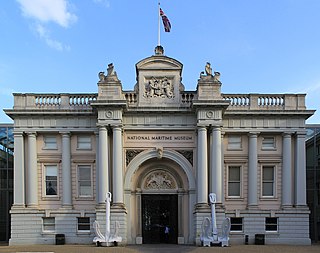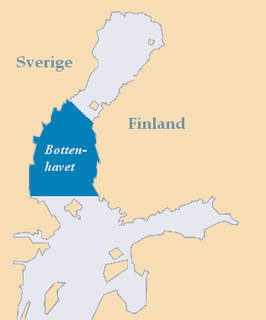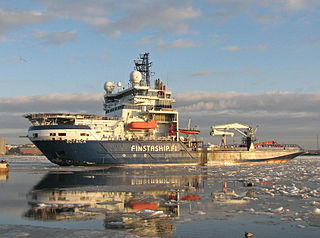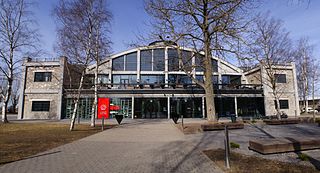
The National Maritime Museum (NMM) in Greenwich, London, is a maritime museum in London. The historic buildings form part of the Maritime Greenwich World Heritage Site, and it also incorporates the Royal Observatory and 17th-century Queen's House. In 2012, Her Majesty the Queen formally approved Royal Museums Greenwich as the new overall title for the National Maritime Museum, Queen’s House, the Royal Observatory, Greenwich, and the Cutty Sark. The museum is a non-departmental public body sponsored by the Department for Culture, Media and Sport. Like other publicly funded national museums in the United Kingdom, the National Maritime Museum does not levy an admission charge, although most temporary exhibitions do incur admission charges.
Rauman maalaiskunta is a former municipality of Finland. It was annexed to Rauma on January 1, 1993. The population of the municipality at the time of annexation was about 9,000. The municipality was originally formed in 1476 when a border was drawn between the town of Rauma and the surrounding countryside. The townspeople had seafaring rights, which the country dwellers lacked. Between the 17th century and early 19th century, customs fees were levied on goods passing either to or from the town, and even a border wall existed. A place in Rauma is still called "Porintulli" – a place for the customs on the road to Pori.
Kodisjoki is a former municipality of Finland.

MSV Fennica is a Finnish multipurpose icebreaker and platform supply vessel. Built in 1993 by Finnyards in Rauma, Finland and operated by Arctia Offshore, she was the first Finnish icebreaker designed to be used as an escort icebreaker in the Baltic Sea during the winter months and in offshore construction projects during the open water season. Fennica has an identical sister ship, Nordica, built in 1994.

Fenno–Skan is the designation of the high voltage direct current transmission between Dannebo in Sweden and Rauma in Finland.

The Bothnian Sea links the Bothnian Bay with the Baltic proper. Kvarken is situated between the two. Together, the Bothnian Sea and Bay make up a larger geographical entity, the Gulf of Bothnia, where the Bothnian Sea is the southern part. The whole Gulf of Bothnia is situated between Sweden, to the West, Finland, to the East, and the Sea of Åland and Archipelago Sea to the South. The surface area of Bothnian Sea is approximately 79,000 km². The largest coastal towns, from south to north, are Rauma and Pori in Finland, and Gävle and Sundsvall in Sweden. Umeå (Sweden) and Vaasa (Finland) lie in the extreme north, near Bothnian Bay.

Mir is a self-propelled Deep Submergence Vehicle. The project was initially developed by the USSR Academy of Sciences along with Design Bureau Lazurith. Later two vehicles were ordered from Finland. The Mir 1 and Mir 2, delivered in 1987, were designed and built by the Finnish company Rauma-Repola's Oceanics subsidiary. The project was carried out under the supervision of constructors and engineers of the Shirshov Institute of Oceanology.
Äijänsuo Arena is an arena in Rauma, Finland. It is primarily used for ice hockey, and is the home arena of Lukko. It opened in 1970 and holds 5400 people. The name of the arena was changed to "Lännen Puhelin Areena" in autumn 2006. And it changed in year 2007 to DNA Areena, when DNA bought/formed with Lännen Puhelin. Now the name is "Kivikylän areena". Opening match of the U18 World Championships will be played at Äijänsuo with Finland hosting Sweden.

The Finnish maritime cluster is a cluster of Finnish companies in maritime industries. In 2016 the total turnover was estimated at 13 billion euros and it employed 48,000 people.

The Maritime Museum of Finland is a museum in Kotka, Finland.

STX Finland Oy, formerly Aker Yards Oy, was a Finnish shipbuilding company operating three shipyards in Finland, in Turku, Helsinki and Rauma, employing some 2,500 people. It was part of STX Europe, a group of international shipbuilding companies owned by the South Korean STX Corporation.

The Stuguflåt Bridge is a stone railway bridge north of Stuguflåten on the Rauma Line over the Rauma River in Oppland, Norway. The bridge is 54.1 meters (177 ft) long, has a 30-meter (98 ft) span, and is 10.6 meters (35 ft) wide.

MSV Botnica is a multipurpose offshore support vessel and icebreaker built by Finnyards in Rauma, Finland, in 1998. She was the newest and technically most advanced state-owned icebreaker of Finland until 2012, when she was sold to the Port of Tallinn for 50 million euro. Botnica is used as an escort icebreaker in the Baltic Sea during the winter months, but carries out subsea and offshore construction works worldwide during the open water season.
Boguslaw Plich is a Polish football manager and a former footballer.

Turva is a Finnish offshore patrol vessel. Built in 2014 by STX Finland Rauma shipyard for the Finnish Border Guard, she is the largest vessel of the fleet as well as the first patrol vessel in Finland powered by liquefied natural gas (LNG).

Rauma Old Town Hall is a building located in the UNESCO World Heritage Site of Old Rauma in Rauma, Finland.

The Seaplane Harbour is a maritime museum in Tallinn, Estonia, opened in spring 2012. The museum is part of the Estonian Maritime Museum.
Rauma shipyard is a shipyard in Rauma, Finland. It was previously operated by STX Finland which is owned by the South Korean STX Corporation. Rauma shipyard is specialized in large ferries, small cruise ships, multipurpose icebreakers and small naval craft.

Rauma Marine Constructions (RMC) is a Finnish shipbuilding company based in Rauma, Finland. The company's main products are car ferries, icebreakers and naval vessels.

















